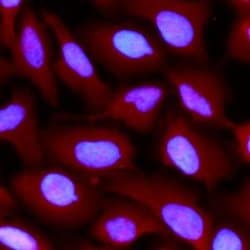Learn More
Invitrogen™ FAK Monoclonal Antibody (ZF002), Alexa Fluor™ 647
Mouse Monoclonal Antibody
Supplier: Invitrogen™ MA396500A647
Description
Focal Adhesion Kinase (FAK) is a 125 kDa non-receptor protein tyrosine kinase that acts as a substrate for Src and is a key element of integrin signaling. FAK plays an important role in cell spreading, differentiation, migration, cell death, and acceleration of the G1 to S phase transition of the cell cycle. Tyrosine 397 is the autophosphorylation site of FAK, and involved in its initial activation. This phosphorylated site binds Src family SH2 domains and the p85 subunit of PI3-Kinase, and activates cell migration and invasion.
Focal Adhesion Kinase (FAK) is a 125 kDa non-receptor protein tyrosine kinase that acts as a substrate for Src and is a key element of integrin signaling. FAK plays an important role in cell spreading, differentiation, migration, cell death, and acceleration of the G1 to S phase transition of the cell cycle. FAK has a central catalytic domain and a C-terminal tail that localizes it to focal adhesions, which are sites where cells attach to the extracellular matrix via surface integrin receptors. Increased FAK tyrosine phosphorylation occurs upon integrin engagement with fibronectin. Adhesion of murine NIH3T3 fibroblasts to fibronectin promotes association of the Grb2 adapter protein and c-Src PTK with FAK in vivo, and also results in activation of the ERK2 MAP kinase. In v-Src-transformed NIH3T3, the association of v-Src, Grb2, and Sos with FAK is independent of cell adhesion to fibronectin. In vitro the Grb2 SH2 domain binds directly to tyrosine-phosphorylated FAK, and the binding site has been identified as Tyr925 by site directed mutagenesis. Several transcript variants encoding different isoforms have been found for the FAK gene, but the full-length natures of only three of them have been determined.
Specifications
| FAK | |
| Monoclonal | |
| 1.0 mg/mL | |
| PBS with 1.0mg/mL BSA and 0.05% sodium azide | |
| O35346, P34152, Q05397 | |
| PTK2 | |
| Recombinant protein derived from the N-terminal region of the mouse and rat FAK-1 proteins. | |
| 50 μg | |
| Primary | |
| Human, Mouse, Rat | |
| Antibody | |
| IgG1 κ |
| Immunocytochemistry | |
| ZF002 | |
| Alexa Fluor 647 | |
| PTK2 | |
| CG10023; CG10023-PA; CG10023-PB; CG10023-PC; CG10023-PD; CG10023-PF; CG10023-PG; CT28129; DFAK; DFak56; Dmel\CG10023; Dmel_CG10023; DmFAK; EC 2.7.10.2; Fadk; FADK 1; Fak; Fak1; Fak56; fak56D; FAK65D; Fak-PA; Fak-PB; Fak-PC; Fak-PD; Fak-PF; Fak-PG; FAK-related non-kinase polypeptide; focal adhesion kinase; Focal adhesion kinase 1; focal adhesion kinase homolog; focal adhesion kinase isoform FAK-Del33; focal adhesion kinase pp125FAK; focal adhesion kinase-related nonkinase; focal ashension kinase 1; FRNK; I79_019430; Kiaa4203; mKIAA4203; p125FAK; p41/p43FRNK; pFAK; pp125 PTK2; pp125FAK; PPP1R71; Protein phosphatase 1 regulatory subunit 71; protein phosphatase 1, regulatory subunit 71; protein tyrosine kinase 2; protein tyrosine kinase 2 L homeolog; protein-tyrosine kinase; protein-tyrosine kinase 2; PTK2; PTK2 protein tyrosine kinase 2; ptk2.L; tyrosine kinase; XELAEV_18032408mg; XPFAK | |
| Mouse | |
| Protein A | |
| RUO | |
| 14083, 25614, 5747 | |
| 4°C, store in dark, DO NOT FREEZE! | |
| Liquid |
Your input is important to us. Please complete this form to provide feedback related to the content on this product.

